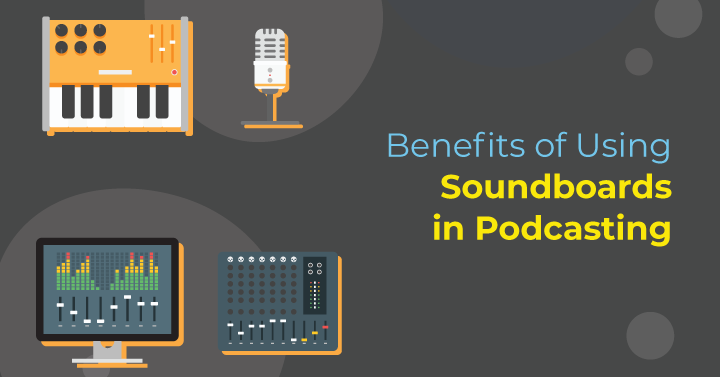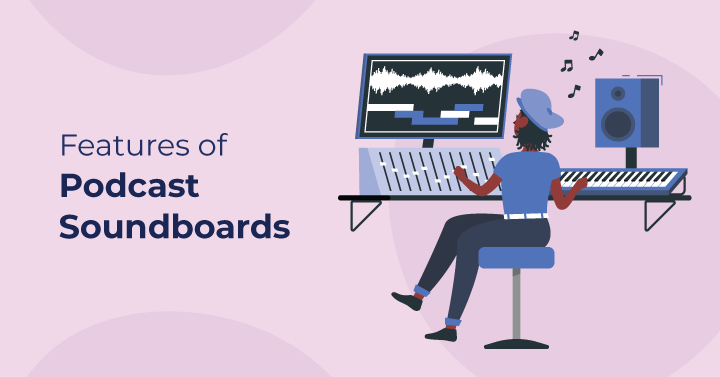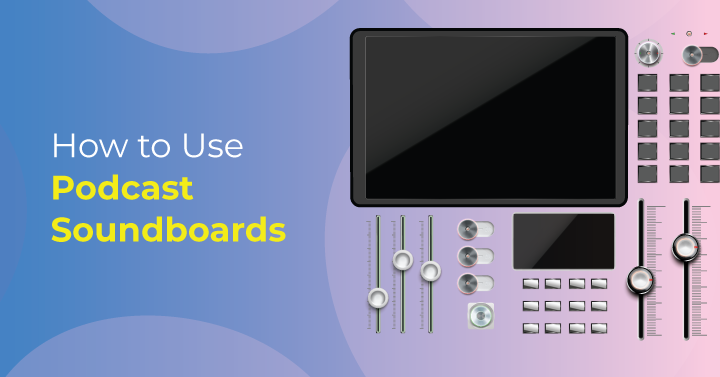
A podcast soundboard is a useful additional tool to upgrade and streamline your recording setup. While it might not be essential for people just starting out on their podcasting journey, it can make the recording process a whole lot easier while also raising your show to a new level in terms of production values.
In this post, we’ll take you through some of the factors to consider when selecting the best soundboard for podcasting for you, as well as the range of features you can have at your disposal.
1. What Is a Podcast Soundboard?
A podcast soundboard is a media library where you can store sound effects (SFX) and music clips. During a live recording, you can use your podcast soundboard to add pre-configured audio at the push of a button.
Soundboards sometimes come with a selection of effects and music preloaded. Others require you to upload any SFX, instrumentals or jingles that you want to use yourself.
2. Benefits of Using Soundboards in Podcasting

Generally speaking, adding sound effects and music beds to your podcast is a great way to increase listener engagement while also lending your show an air of professionalism. Soundboards facilitate this process by making inserting sound effects much smoother to manage.
Another benefit of using a soundboard in podcasting is that you can preload any audio (or even video) you may want to use ahead of time, then cue it up at the appropriate moment using a button or key. Incorporating clips or effects during the recording is easier than trying to shoehorn SFX in during the editing stage and will also reduce your production time overall.
Plus, a soundboard doesn’t necessarily have to cost you a thing. There are lots of free digital options available that you can find online.
3. Types of Podcast Soundboards
3.1. Hardware soundboards
When people talk about hardware soundboards, they are usually referring to mixers. This piece of equipment is designed to accept multiple inputs from mics and/or instruments, while simultaneously allowing you to adjust the quality of the sound. Some models also feature programmable buttons, which can be assigned specific SFX that you can then play as desired.
A number of companies have designed hardware specifically to be used for podcasts, such as the Rodecaster Pro, which has a built-in sound pad that makes it very easy to insert sound effects while you are recording a show.
3.2. Software soundboards
Software soundboards enable you to add a range of podcast sound effects to your episodes live through a digital interface. There are several different options available. For instance, you may want a podcast soundboard download, which you can then run offline using your computer, or you may want a podcast soundboard online, which means you don’t need to allocate storage space on your device.
Usually, you won’t need to worry about searching specifically for a podcast soundboard for Mac or Windows, as most programs work on both operating systems.
3.3. Mobile app soundboards
Mobile app soundboards are essentially the same as software soundboards, except they can be run from your mobile phone. This makes them extremely portable and particularly useful for people who aren’t recording in a regular studio.
4. Features of Podcast Soundboards

4.1. Audio playback controls
The most basic feature of a podcast soundboard is the audio playback controls, which allow you to play, stop or pause your media. The most direct way to do this is using your mouse to point and click. You can also assign hotkeys to different sound effects, which can be a more efficient way of initiating audio playback but requires more setup and practice.
4.2. Sound effects and jingles
There are two main categories of audio input you can add using a soundboard: sound effects (e.g., birds tweeting, crowd cheers, gurgling water) and music clips (instrumental riffs, jingles). A lot of the time, the music clip you will be playing will be your show’s jingle. You can think of jingles as the theme song to your show, something that you play during the intro and outro of every episode as an identifier. You may also have the same or a different jingle that you use for transitions.
4.3. Voice changer and modulation
Most people are probably familiar with voice changers and modulators from interviews where the interviewee wishes to remain anonymous. For podcasters, however, this is a secondary use case. Mostly, podcasters use voice changers and modulation either because they aren’t happy with the way their voices sound or to add a different audio element to a recording, so as to keep listeners engaged.
4.4. Custom sound uploading
You may be content to rely on the modest library of sounds that comes with your chosen soundboard. Usually, you will want to upload your own selection, which can be downloaded from an online repository of music like Freesound. You can also make your own creations and upload them to your platform, which takes more time and effort but also gives your show a distinctive, personalized edge.
4.5. Live audio mixing
One of the benefits of using a soundboard in podcasting is that it allows you to add SFX live. Some soundboards even come integrated into recording programs, which is handy because it means you don’t have to have a separate piece of mixer hardware or digital software to combine the soundboard noises with your mic inputs into one recording.
5. How to Use Podcast Soundboards

5.1. Prepare your sound clips and effects
The first thing to do is line up the sound effects, music and jingles you want to use in your episode. Get into the habit of including notes on your podcast script regarding any additional audio inputs you want to feature, as this will make it easier to prepare the SFX ahead of time.
Sites like ZapSplat provide a range of royalty-free music tracks and sound effects that you can easily download to your computer, then upload to your soundboard. Other sites like Music Radio Creative sell things like voiceover services and jingle bundles that you can incorporate into your show. If you have a bit more time, energy and creativity, you can also make your own custom sounds.
5.2. Connect your soundboard to your recording setup
Unless you have a soundboard that is integrated natively into your recording software, you will need to have a way to link the soundboard to your recording setup. There are two principal methods for doing this. One is to connect everything to a mixer, which will process all the inputs and output them to your recording device (most probably your computer).
The second method is to use audio routing software to connect the soundboard directly into the recording setup on your computer. Applications like Loopback, for example, combine the input channels from external mics with the input channel from your digital soundboard on your PC or laptop.
5.3. Familiarize yourself with your soundboard’s features
As you would expect, different soundboards offer different features. Some platforms include the ability to adjust EQ and gain as part of the soundboard’s feature, making them more like a virtual mixer. Others focus purely on providing an interface where you can add sounds and clips. Still others specialize in a particular effect. Voice.ai, for example, focuses on AI-enabled voice alteration.
The best way to discover what a soundboard can do is to experiment. Several of the digital options out there offer a free tier or at least a complimentary trial where you can see what the program has to offer before you buy.
5.4. Incorporate soundboards into your podcast recording
Once you have familiarized yourself with your soundboard’s features, you’ll have a better idea of how they can be incorporated into your recording setup to lighten the mood, create a sense of foreboding or simply create a more well-rounded audio experience.
5.5. Use soundboards effectively
A soundboard can be invaluable for streamlining your recording process and adding an extra layer of experience for your listeners, but it can also become gimmicky or grating if overused. There are really no hard and fast rules about how much you should use a soundboard, it’s just one of those things that comes with experience – and feedback from friends or colleagues!
5.6. Edit your podcast with soundboard effects
While we’ve mostly talked about the usage of soundboards during the recording process, don’t forget that they can also be used in editing. Sometimes it might not cross your mind when you’re scripting an episode that a sound effect or some instrumental music might be appropriate, but during post-production you decide that little audio snippet might raise the level of your show.
6. FAQs
- Do you need a soundboard for a podcast?
Soundboards aren’t essential for a podcast, but they can elevate the production of your show. Used effectively, they can make your podcast more dynamic and engaging for listeners
- Can podcasts have sound effects?
Absolutely. Using sound effects in podcasts can be a great way to add tone and ambiance, all at the push of a button.
- Does podcast soundboard work on Discord?
Yes, you can incorporate a podcast soundboard into Discord. To do so, you will need to install a virtual audio cable, which will route your soundboard into the Discord app. Discord is currently trialing a native soundboard as well, but it’s currently only available to select communities.
- What is the purpose of a soundboard?
At its most simple, the purpose of a soundboard is to store sound effects or music that can then be inserted into an audio feed. This can be done live or in editing.
- What is the use of soundboard?
Soundboards can be used to add audio effects to podcast recordings, live streams, video chats or music tracks. Wherever you might want to add in SFX, you can use a soundboard to smooth the process.
- How does a soundboard work?
Essentially, a soundboard works by storing a collection of media, which can then be played using a physical or virtual sound pad to create a particular mood or effect.
- What is soundboard audio?
Soundboard audio is the audio that you insert into live chats or recordings to convey a bit of personality. In the context of podcasts, it is often used to communicate tone or set a particular ambiance.



